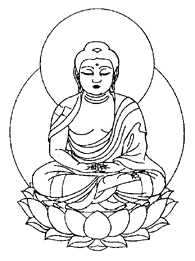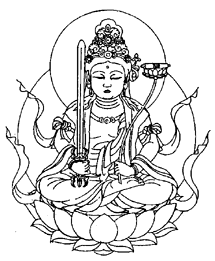Om may defilements be removed sv‚h‚
In another source, the Cho Ku Rei symbol represents the essence or bija of the Vajra (Thunderbolt.)
In Buddhism, the Vajra is used as a symbol of wisdom, having power over illusion and negative thoughts.
The CKR is the only Reiki symbol that doesn't come from a written language, which may mean that it is older than
most written languages.
The counter-clockwise movement of the CKR symbol is used to bring gifts from the Universe into our lives.
At the center of the Vajra, and therefore the Power Symbol, is the sound of HUM. H represents freedom from cause and effect;
U represents freedom from arguments; and M represents the groundlessness of the Absolute Reality.
The Cho Ku Rei symbol, as the seed symbol of the vajra, contains the five wisdoms know as Mirrorlike Wisdom, Wisdom of Sameness,
Discriminating Wisdom, Active Wisdom and Wisdom of the Pure Absolute.
Due to this symbols association with the vajra, it is associated with the Great Bodhisattva Vajrapana(Thunderbolt in the Hands) and
the Great Mother Vajradhara.
* * * *

AMIDA NYORAI-Buddha of Infinite Life and Light
Bija

Amida Nyorai is associated with the Mental/Emotional or Sei Hei Ki Symbol
Description Of Form
Amit‚bha (Amida) is seated in lotus position on a jewel lotus. He
wears a red robe with both shoulders covered. He is sitting with both
of his hands held in his lap. The tips of his thumbs are touching, and
the ends of his first fingers are turned up, forming two circles. His
right hand is resting on his left hand, and this mudr‚ is called the
Sam‚dhi mudr‚.
Purpose and Vow
Amida Nyorai is widely known for the practice of chanting "Namu
Amida Butsu," the six syllables of his sacred name, in the Pure Land
tradition of Buddhism. In the Pure Land (JŰdoshŻ) and True Pure
Land (JŰdoshinshŻ) Schools, Amida Nyorai is the main deity, and
spiritual peace of mind lies in being able to attain salvation by relying
on his power. By this doctrine, it is explained in the widely read
Amida Sutra that "the Buddha's radiance is infinite and illumines all of
the countries in the ten directions totally without obstruction. That is
why he is called the Buddha of Infinite Light. The life span of the
Buddha is infinite, without limit, and never ends; and therefore he is
called the Buddha of Infinite Life." The name Amida is from the
Sanskrit word meaning infinite life, and because Amida's compassion
is infinite and without boundaries, he is also called the Buddha of
Infinite Life.
Amida Nyorai presides over the Pure Land of the Western Paradise,
holds to many vows specified in the Forty-eight Vows of Amida, and
is particularly known for "Amida's coming and greeting" by which he
will come with a host of attending bodhisattvas to greet a person who
is about to die and lead that person to the Pure Land. This is also
referred to as the power of the Original Vow made for the sake of
saving people. Amida's name is recited as words of thanksgiving for
the power of the Original Vow.
In his "TannishŰ" Shinran ShŰnin, the founder of the True Pure Land
School, said, "The good person will be reborn; how much more so
the evil person." This explains the power of the Original Vow that can
make even evil persons be reborn in the Pure Land through the
power of the Original Vow of Amida Nyorai. This idea is called
"akunin shoki," which means "evil people have the right qualifications"
for rebirth. This speaks of how even evil can bring about the blessing
of the right circumstances for encountering Buddhism, and how
extensive are the relationships that one can have with the Buddha and
thus be enabled to be reborn in the Pure Land through the Buddha?s
power. This expresses the vow of Amida Nyorai never to abandon
even those who have committed serious transgressions. The special
characteristic of Amida Nyorai is that "Amida will come and greet
you." This is the idea that when a person dies, Amida will come with
twenty-five attendant bodhisattvas to greet and lead that person to
the Pure Land.
Mantra
On amirita teizei kara un (Jpn.)
Om amrta-teje hara hŻm (Skt.)
Om save us in the glory of the Deathless One hŻm!
The Sei Hei Ki is a seed or bija symbol that respresents the quality within the power of the Universe which enables
a person to rise to a higher state of consciousness. It allows one to achieve the necessary state of mind to attain Enlightenment
or Onesness with God. The quality of the SHK symbol is compassion. Therefore, Bodhisattva Avalokitesvara (Kannon, Kwan Yin) is
represented by the SHK symbol, as well.
* * * *

KANNON BOSATSU (Quan Yin) Bodhisattva of Infinite Compassion and Mercy
Bija

Kannon Bosatsu (Quan Yin) is associated with the Connection or Hon Sha Ze Sho Nen Symbol
Description Of Form
His body is golden and he sits within a background of flames. He
wears Bodhisattva robes with a red undergarment. His right hand is
at the level of the chest and holds an opened lotus, which represents
the Bodhichitta. His left hand is also at the level of the chest and
makes the mudr‚ of fearlessness.
Purpose and Vow
In the arena of Buddhist piety, no other buddha is worshipped by as
many people as is Kanzeon (Avalokitesvara) Bodhisattva. All
together, there are one hundred Avalokitesvaras combined in the
pilgrimage routes of the Thirty-Three Temples of Shikoku, the
Thirty-Four Temples of Chichibu, and the Thirty-Three Temples of
Bando. In addition, there are countless other Avalokitesvaras
enshrined as the main deity in other temples.
As indicated by his name, Kanzeon Bodhisattva, the Bodhisattva
Who Perceives the Sounds of the World, made a vow to hear the
voices of people and the sounds of the conditions of the world,
immediately grant salvation to the suffering and the afflicted, and
dispel the evil and calamities that surround us.
As a result, Avalokitesvara can change into many different forms,
appear in different times and places freely without restriction to save
people, and is therefore known also as the Bodhisattva Who
Perceives Without Restrictions. There are thirty three forms that
Avalokitesvara can take to carry out acts of salvation freely, and this
is the origins of the thirty-three pilgrimage stages.
The most fundamental forms of these many manifestations are the
Seven Avalokitesvaras, these include:
1. Ary‚valokitesvara (ShŰ Kannon) the Sacred Avalokitesvara
2. Ekadasamuhka (JŻichimen Kannon) the Eleven Faced Avalokitesvara
3. Sahasrabhuja (Senju Kannon) the Thousand Armed Avalokitesvara
4. Cint‚manicakra (Nyoirin Kannon) the Wish Fulfilling Avalokitesvara
5. HayagrÓva (BatŰ Kannon) the Horse Headed Avalokitesvara
6. Cundi (Juntei Kannon) the Mother Goddess Avalokitesvara
7. Amoghapasa (FukŻkenjaku) the Avalokitesvara with rope and net
Generally taking on a gentle female form, Avalokitesvara is
understood to protect living beings with loving compassion, but she
can also take on a stern faced, fiery and angry appearance such as
we find in HayagrÓva (BatŰ Kannon), the Horse Faced
Avalokitesvara, who gives guidance and protection in the animal
world.
Avalokitesvara can also devote her energies to acts of
salvation in the guise of many different faces, such as is found in the
Eleven Faced Avalokitesvara; or perform acts of compassion with
many hands, such as is done by the Thousand Armed
Avalokitesvara. The Avalokitesvara Who Ensnares Unerringly stands
for a fishing net and rope, and the net is dragged through the world to
extend the hand of salvation to people without leaving anyone out.
The Mother Goddess Avalokitesvara refers to the Buddha's Mother,
and is a deity who nurtures people like a mother.
Avalokitesvara (Kannon) is also called Kanzeon Bodhisattva, and
this name indicates that this Bodhisattva can hear the voices and
concerns of the world, and, in order to provide immediate relief, can
change into many different forms to save people freely at will
according to their time and place. That is why Avalokitesvara is
called Kanjizai Bodhisattva, the Bodhisattva That Sees and Acts
Freely at Will, and is spoken of in the Avalokitesvara Sutra as having
thirty-three different forms. This is the origin of the AvalokiteŖvara
(Kannon) pilgrimage covering thirty-three sites.
Mantra
On arorikya sowaka (Jpn.)
Om ‚rolik sv‚h‚ (Skt.)
Om Unstained One sv‚h‚
Another source gives valuable argument to suggest that the Distance Symbol (HSZSN) appears to be the bija or seed symbol
for Manjushri (Gentle Glory), who can be found alongside Avalokitesvara in the eastern segment of the second level of the Healing
Buddha Mandala. Manjushri is the Bodhisattva who personifies wisdom and intellect.
* * * * *

MANJUSHRI BODDHISATTVA
Description Of Form
MaŮjusri Bodhisattva (Monju) holds in his left hand a sutra by which
he dispenses wisdom to people, and in his right hand holds a sword
for cutting off delusion. He sometimes rides on a lion, which is called
the king of a hundred animals, and this expresses how he lives
grandly with a powerful and correct wisdom.
Purpose and Vow
There is an old saying that the wisdom of MaŮjusri (Monju) lies in
putting together three heads, which are better than one. The figure of
MaŮjusrii (Monju) Bodhisattva is greatly endowed with wisdom, and
in his right hand he holds the scriptures that confer that wisdom, while
he also holds a sword that can cut off delusion. Bodhisattva refers to
a living person who seeks enlightenment. In reality, the Bodhisattva
practices Buddhism in society and is a buddha that acts on behalf of
the Nyorai in saving people. MaŮjusri (Monju) Bodhisattva cuts off
the mistaken ideas of the world as well as evil thoughts and actions,
corrects the ignorance and delusions of people, dispenses true
wisdom, and delivers joy to human society.
Mantra
On a rahashanŰ (Jpn.)
Om ara pa ca na (Skt.)
Om a ra pa ca na
[BACK TO MANUAL]
MOST OF THE INFORMATION ON THIS PAGE WAS TAKEN FROM THE SHINGON BUDDHIST INTERNATIONAL INSTITUTE WEBPAGE AT:
SHINGON BUDDHIST INTERNATIONAL INSTITUTE.

Email: mikaousui@msn.com






